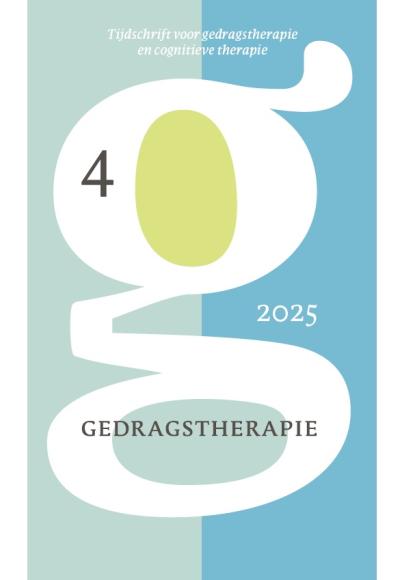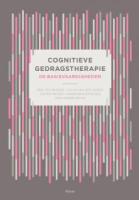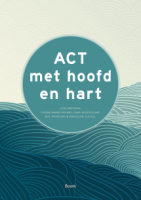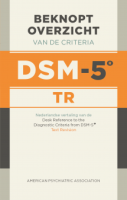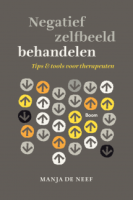Inhoud
De therapeutische relatie als onderhandelingsproces: het resolutiemodel voor alliantiebarsten van Safran
Samenvatting
Jeremy Safran behoort tot de meest invloedrijke interpersoonlijke theoretici en therapeuten van dit moment. In zijn interpersoonlijke therapiemodel richt hij zich specifiek op het de detectie en het herstel van alliantiebarsten. Volgens Safran en zijn medewerkers is het constructief oplossen van alliantiebarsten in het ‘hier en nu' van de therapeutische relatie een unieke manier om de patiënt te helpen disfunctionele interpersoonlijke schema's te boven te komen. Nog belangrijker: een dergelijk proces kan voor de patiënt een betekenisvolle ‘correctief emotionele ervaring' bieden voor een negatieve interpersoonlijke leergeschiedenis. In Nederland is het werk van Safran nauwelijks bekend onder cognitieve gedragstherapeuten. Dit artikel beschrijft zijn resolutiemodel voor alliantiebarsten in de therapeutische relatie.
Literatuur
- Bowlby, J. (1979). The making and breaking of affectional bonds. London: Routledge.
- Bowlby, J. (1988). A secure base: clinical applications of attachment theory. London: Routledge.
- Callaghan, G.M., Gregg, J.A., Marx, B.P., Kohlenberg, B.S., & Gifford, E. (2004). FACT: the utility of an integration of Functional Analytic Psychotherapy and Acceptance and Commitment Therapy to alleviate human suffering. Psychotherapy: Research, Practice, Training, 41, 195-207.
- Duncan, L.B., Miller, S.D., & Sparks, J. (2004). The heroic client: a revolutionary way to improve effectiveness through client-directed, outcome-informed therapy. San Francisco: Jossey-Bass.
- Gilbert, P., & Leahy, R.L. (eds). The therapeutic relationship in the cognitive behavioral therapies. London: Routledge.
- Hafkenscheid, A. (2003a). Een interpersoonlijke en emotionele impuls voor de cognitieve therapie. Boekbespreking van Jeremy Safran (1998), Widening the scope of cognitive therapy: the therapeutic relationship, emotion and the process of change. Gedragstherapie, 36, 223-235.
- Hafkenscheid, A. (2003b). Objective countertransference: do patients' interpersonal impacts generalise across therapists? Clinical Psychology & Psychotherapy, 10, 31-40.
- Hafkenscheid, A. (2004a). De interpersoonlijke communicatietheorie (ICT) van Donald J. Kiesler (1) De theorie. Psychopraxis, 6, 15-19.
- Hafkenscheid, A. (2004b). De interpersoonlijke communicatietheorie (ICT) van Donald J. Kiesler (2). De praktijk. Psychopraxis, 6, 59-64.
- Hafkenscheid, A. (2004c). Hoe 'Rogeriaans' is de interpersoonlijke communicatietheorie en -therapie (ICT) van Donald J. Kiesler? Tijdschrift voor Cliëntgerichte Psychotherapie, 42, 267-278.
- Hafkenscheid, A. (2005). The Impact Message Inventory (IMI-C): Generalisability of patients' command and relationship messages across psychiatric nurses. Journal of Psychiatric and Mental Health Nursing), 12, 325-332.
- Hafkenscheid, A. (2007a). Evidence-Based Practice (EBP) of Practice-Based Evidence (PBE)? Boekbesprekingen van John C. Norcross, Larry E. Beutler & Ronald F. Levant (eds.). (2005). Evidence-based practices in mental health: debate and dialogue on the fundamental questions. Washington: American Psychological Association.
- John C. Norcross (ed.) (2002). Psychotherapy relationships that work: therapist contributions and responsiveness to patients. Oxford, New York: Oxford University Press. Gedragstherapie, 40, 125-139.
- Hafkenscheid, A. (2007b). De betekenis van Donald J. Kiesler (1933-2007) voor de psychotherapie. Tijdschrift voor Psychotherapie, 33, 333-345.
- Hafkenscheid, A. (2009). De interpersoonlijke component. In: Colijn, S., Snijders, H., Thunnissen, M., Bögels, S. & Trijsburg, W. (red.). Leerboek Psychotherapie (pp. 109-121). Utrecht: De Tijdstroom.
- Hafkenscheid, A., & Kiesler, D. (2007). Assessing objective countertransference: a comparison of two different statistical procedures in three different samples. Psychotherapy Research, 17, 393-403.
- Hafkenscheid A., & Rouckhout, D. (2009). Circumplex structure of the Impact Message Inventory (IMI-C): An empirical test with the Dutch version. Journal of Personality Assessment, 91, 187-194.
- Hafkenscheid, A., Veeninga, A., & Witzenburg, D. van (2009). Routine process monitoring (RPM) en Functionele Analytische Psychotherapie (FAP) in aanvulling op een protocollaire cognitief gedragstherapeutische behandeling. Gedragstherapie, 42, 167-183.
- Hayes, S.C., Strosahl, K., & Wilson, K.G. (1999). Acceptance and Commitment Therapy: an experiential approach to behavior change. New York: Guilford Press.
- Hermans, D., Eelen, P., & Orlemans, H. (2007). Inleiding tot de gedragstherapie. Houten: Bohn, Stafleu van Loghum.
- Horowitz, L.M. (2004). Interpersonal foundations of psychopathology. Washington: American Psychological Association.
- Katzow, A., & Safran, J.D. (2007). Recognizing and resolving ruptures in the therapeutic alliance. In: P. Gilbert, P. & R.L. Leahy (eds). The therapeutic relationship in the cognitive behavioral therapies (pp. 90-105). London: Routledge.
- Kiesler, D.J. (1988). Therapeutic metacommunication: therapist impact disclosure as feedback in psychotherapy: Palo Alto: Consulting Psychologists Press, Inc.
- Kiesler, D.J. (1996). Contemporary interpersonal theory and research: personality, psychopathology, psychotherapy. New York: John Wiley & Sons, Inc.
- Kiesler, D.J., & Schmidt, J.A. (2006). The Impact Message Inventory-Circumplex (IMI-C) Manual: Sampler set, manual, test booklet, scoring key, worksheets. Menlo Park: Mind Garden.
- Kohlenberg, R.J., & Tsai, M. (1991). Functional Analytic Psychotherapy: creating intense and curative therapeutic relationships. New York: Plenum Press.
- Korrelboom, K., & Ten Broeke, E. (2004). Geïntegreerde cognitieve gedragstherapie: handboek voor theorie en praktijk. Bussum: Coutinho.
- Lambert, M.J., & Barley, D.E. (2002). Research summary on the therapeutic relationship and psychotherapy outcome. In: J.C. Norcross (ed.). Psychotherapy relationships that work: therapist contributions and responsiveness to patients (pp. 17-32). New York: Oxford University Press.
- Lambert, M.J., & Ogles (2004). The efficacy and effectiveness of psychotherapy. In: M.J. Lambert (ed.). Bergin and Garfield's handbook of psychotherapy and behavior change (pp. 139-193). New York: John Wiley & Sons.
- Luoma, J.B., Hayes, S.C., & Walser, R.D. (2008). Leer ACT! Vaardigheden voor therapeuten. Houten: Bohn, Stafleu, Van Loghum.
- Muran, J.C. (2002). A relational approach to understanding change: plurality and contextualism in a psychotherapy research program. Psychotherapy Research, 12, 113-138.
- Muran, J.C., Safran, J.D., Samstag, L.W. &, Winston, A. (2005). Evaluating an alliance-focused treatment for personality disorders. Psychotherapy: Theory, Research, Practice, Training, 42, 532-545.
- Safran, J.D. (1990a). Towards a refinement of cognitive therapy in light of interpersonal theory: I. Theory. Clinical Psychology Review, 87-105.
- Safran, J.D. (1990b). Towards a refinement of cognitive therapy in light of interpersonal theory: II. Practice. Clinical Psychology Review, 107-121.
- Safran, J.D. (1993a). Breaches in the therapeutic alliance: an arena for negotiating authentic relatedness. Psychotherapy, 30, 11-24.
- Safran, J.D. (1993b). The therapeutic alliance rupture as a transtheoretical phenomenon: definitional and conceptual issues. Journal of Psychotherapy Integration, 3, 33-49.
- Safran, J.D. (1998). Widening the scope of cognitive therapy: the therapeutic relationship, emotion, and the process of change. Northvale: Jason Aronson.
- Safran, J.D. (1999). Faith, despair, will and the paradox of acceptance. Contemporary Psychoanalysis, 35, 5-24.
- Safran, J.D., & Muran, J.C. (1996). The resolution of ruptures in the therapeutic alliance. Journal of Consulting and Clinical Psychology, 64, 447-458.
- Safran, J.D., & Muran, J.C. (2000a). Resolving therapeutic alliance ruptures: diversity and integration. JCLP/In Session: Psychotherapy in Practice, 56, 233-243.
- Safran, J.D., & Muran, J.C. (2000b). Negotiating the therapeutic alliance: a relational treatment guide. New York: The Guilford Press.
- Safran, J.D., Muran, J.C., Samstag, L.W., & Stevens, C. (2002). Repairing alliance ruptures. In: J.C. Norcross (ed.). Psychotherapy relationships that work: therapist contributions and responsiveness to patients (pp. 235-254). New York: Oxford University Press.
- Safran, J.D., Muran, J.C., Samstag, L.W., & Winston, A. (2005). Evaluating alliance-focused intervention for potential treatment failures: a feasibility study and descriptive analysis. Psychotherapy: Theory, Research, Practice, Training, 42, 512-531.
- Safran, J.D., & Muran, J.C. (2006). Has the concept of the therapeutic alliance outlived its usefulness? Psychotherapy: Theory, Research, Practice, Training, 43, 286-291.
- Samstag, L.W., Batchelder, S.T., Muran, J.C., Safran, J.D., & Winston, A. (1998). Early identification of treatment failures in short-term psychotherapy: an assessment of therapeutic alliance and interpersonal behaviour. The Journal of Psychotherapy Practice and Research, 7, 126-143.
- Schmidt, J.A., Wagner, Chr. C., & Kiesler, D.J. (1999). Psychometric and circumplex properties of the octant scale Impact Message Inventory (IMI-C): a structural evaluation. Journal of Counseling Psychology, 46, 325-334.
- Willemse, Y., & Hafkenscheid, A. (2009). Stagnaties in de therapeutische alliantie signaleren en repareren. Tijdschrift voor Psychotherapie, 35, 342-357.
 © 2009-2025 Uitgeverij Boom Amsterdam
© 2009-2025 Uitgeverij Boom Amsterdam
De artikelen uit de (online)tijdschriften van Uitgeverij Boom zijn auteursrechtelijk beschermd. U kunt er natuurlijk uit citeren (voorzien van een bronvermelding) maar voor reproductie in welke vorm dan ook moet toestemming aan de uitgever worden gevraagd:
Behoudens de in of krachtens de Auteurswet van 1912 gestelde uitzonderingen mag niets uit deze uitgave worden verveelvoudigd, opgeslagen in een geautomatiseerd gegevensbestand, of openbaar gemaakt, in enige vorm of op enige wijze, hetzij elektronisch, mechanisch door fotokopieën, opnamen of enig andere manier, zonder voorafgaande schriftelijke toestemming van de uitgever.
Voor zover het maken van kopieën uit deze uitgave is toegestaan op grond van artikelen 16h t/m 16m Auteurswet 1912 jo. Besluit van 27 november 2002, Stb 575, dient men de daarvoor wettelijk verschuldigde vergoeding te voldoen aan de Stichting Reprorecht te Hoofddorp (postbus 3060, 2130 KB, www.reprorecht.nl) of contact op te nemen met de uitgever voor het treffen van een rechtstreekse regeling in de zin van art. 16l, vijfde lid, Auteurswet 1912.
Voor het overnemen van gedeelte(n) uit deze uitgave in bloemlezingen, readers en andere compilatiewerken (artikel 16, Auteurswet 1912) kan men zich wenden tot de Stichting PRO (Stichting Publicatie- en Reproductierechten, postbus 3060, 2130 KB Hoofddorp, www.cedar.nl/pro).
No part of this book may be reproduced in any way whatsoever without the written permission of the publisher.
Inloggen VGCt en VVGT
Leden van de VGCt en de VVGT loggen in via de site van hun vereniging. Als u op die site bent ingelogd als lid, vindt u daar een button naar het Tijdschrift voor Gedragstherapie.
English
Behavioral Therapy: Journal for Behavioral Therapy and Cognitive Therapy ISSN 0167-7454
Information in English can be found here.



